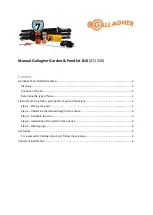
If this were a 0.01 PF transducer, then the firmware would compare the accuracy values
between the Setting Screen and the Test Screen and would display
PASS
in the
Transducer Output
section of the test screen.
3.8.10.7.3
Watt/VAR1 1/2 Element
This transducer is normally used in single-phase, three wire applications, which requires
2 voltages and 2 currents to test. The MPRT will automatically select the first two voltage
and current channels available,
V1
,
V2
,
I1
and
I2
. The voltage input to the transducer is
supplied with one voltage input terminal. However, we must take into account that the
transducer is connected using a PT that is connected line to line. Thus the test will initially
start at the default voltage value, that is set in the
Default Setting Screen
, for each
Voltage output. However, the V2 output will be 180 degrees out of phase with V1, thus
they add across the potential input of the transducer. For example, a default of 120 Volts
L-N, means 240 Volts will be impressed across the transducer potential input terminals.
Thus V1 will be set to 120 Volts at an angle of 0
°
, and V2 will be 120 Volts at 180
°
. I1 and
I2 will be in-phase with their respective voltages (0
°
and 180
°
). When the user inputs the
MAX.
Watts value in the
Transducer Setting Screen
, the firmware can calculate the
required test currents for full scale value.
The formula required to calculate Watts for 1 1/2 Element transducer is,
V1 * I1 * COS
∅
+ V2 * I2 COS
∅
= Watts
Example: The default voltage is 120.00 Volts AC, and the user inputs 1000 Watts as
Max. Value. The current required for full scale output from the transducer is,
120 * I1 * COS 0
°
+ 120 * I2 * COS 0
°
= 1000 Watts
Since each phase contibutes half of the power, we can simplify to,
I1 = 500 Watts/120 Volts, or I1= I2 = 4.1667 Amperes
Therefore, when the user inputs 1000 Watts in the
MAX
. value window, in the Test
Screen the test set should automatically show a test current value for I1 of 4.167
Amperes at an angle of 0
°
, and I2 will be 4.167 Amperes at an angle of 180
°
. Note that
the current is rounded up to 7 in the last digit displayed.
When the test is Started, the measured voltage and current outputs are displayed and the
calculated Watts is based on the measured voltage and current outputs. This is the value
that gets displayed in the
Transducer Test Screen
under the
MPRT Output
, next to the
Label of
Watt 1 1/2 Element
Another value of Watts gets calculated using the measured
dc Volts or dc milliampere output as displayed in the
Transducer Output
section. Let us
assume that in our example transducer, the output is in dc milliamperes. For this
example, let us say that 1 milliampere of dc current is equal to the full scale output of
1000 Watts. Therefore, the theoretical output Watts from the transducer would be 1000
Watts, if the output current is 1 milliampere. For this example, let's say that the measured
output voltages are 120.00 Volts (V1 and V2) and the measured output currents are
4.166, Amperes, at 0
°
. The measured output Watts would be,
120.00 * 4.166 * COS 0
°
+120.00 * 4.166 * COS 0
°
= 999.94 Watts
For this example, let's assume the measured output current from the transducer is 0.998
mA dc. Based on a Max. value of 1 mA equals 1000 Watts, the displayed
Watts
in the
-
144
www
. ElectricalPartManuals
. com
















































